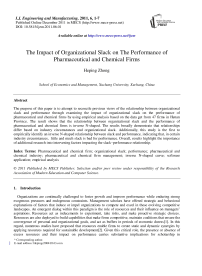The Impact of Organizational Slack on The Performance of Pharmaceutical and Chemical Firms
Автор: Heping Zhong
Журнал: International Journal of Engineering and Manufacturing(IJEM) @ijem
Статья в выпуске: 6 vol.1, 2011 года.
Бесплатный доступ
The purpose of this paper is to attempt to reconcile previous views of the relationship between organizational slack and performance through examining the impact of organizational slack on the performance of pharmaceutical and chemical firms by using empirical analysis based on the data get from 47 firms in Henan Province. The result shows that the relationship between organizational slack and the performance of pharmaceutical and chemical firms is inverse N-shaped. The results broadly demonstrate that relationships differ based on industry circumstances and organizational slack. Additionally, this study is the first to empirically identify an inverse N-shaped relationship between slack and performance, indicating that, in certain industry circumstances, little and much slack is bad for performance. Overall, results highlight the importance of additional research into intervening factors impacting the slack–performance relationship.
Pharmaceutical and chemical firm, organizational slack, performance, pharmaceutical and chemical industry, pharmaceutical and chemical firm management, inverse N-shaped curve, software application, empirical analysis
Короткий адрес: https://sciup.org/15014244
IDR: 15014244
Список литературы The Impact of Organizational Slack on The Performance of Pharmaceutical and Chemical Firms
- George,G..Slack resources and the performance of privately held firms[J].Academy of Management Journal,2005,48(4):661-676.
- Foss, N.J. and Christensen, J.F. A market-process approach to corporate coherence[J]. Managerial and Decision Economics, 2001, 22(4/5):213-26.
- Yi-Chia Chiu, Yi-Ching Liaw. Organizational slack: is more or less better?[J].Journal of Organizational Change Management, 2009, 22(3):321–342.
- Singh J. Performance, slack, and risk taking in organizational decision making[J]. Acad Manage J, 1986, 29:562– 85.
- Tan, J., Peng, M. W. Organizational Slack and Firm Performance During Economic Transitions: Two Studies from an Emerging Economy[J]. Strategy Management Journal, 2003, 24(13): 1249-1263.
- Penrose E. "The theory of the growth of the firm". Oxford: Oxford University Press, 1959.
- Cyert,R.M., March,J.G. A behavioral theory of the firm[M]. Prentice-Hall, Englewood Cliffs, NJ. 1963.
- Jensen M. Agency costs of free cash flow, corporate finance, and takeovers. Am Econ Rev 1986;76:323–9.
- Bourgeois L. On the measurement of organizational slack. Acad Manage Rev, 1981, 6:29– 39.
- Sharfman, M. P., Wolf, G., Chase, R. B., & Tansik, D. A. Antecedents of organizational slack[J]. Academy of Management Review, 1988,13(4): 601-614.
- Francis Daniel et al. Slack resources and firm performance: a meta-analysis[J]. Journal of Business Research, 2004,57:565-574.
- Greenley G, Okemgil M. A comparison of slack resources in high and low performing British companies. J Manage Stud 1998;35:377– 98.
- Nohria, N., Gulati, R. Is slack good or bad for innovation? [J]. Academy of Management Journal, 1996, 39 (5): 1245-1264.
- Geiger,S.W., Makri,M.. Exploration and exploitation innovation process: The role of organizational slack in R & D intensive firms[J]. Journal of High Technology Management Research, 2006,17(1): 97-108.
- Zhong Heping,Fang Runsheng,Sun Lianjian,Sun Xinqing. Human Resource Slack and Performance: Evidence from Henan Province in China[C]. Proceedings of The Second International Conference on Management Science and Engineering Management. England:World Academic Union,2008:513-519.
- Mishina, Y., Pollock, T.G., & Porac, J.F. "Are more resources always better for growth? Resource stickiness in market and product expansion". Strategic Management Journal, 2004, 25(12): 1179–1197.
- Thompson J. Organization in Action. McGraw-Hill: New York. 1967.
- Bromiley, P. Testing a causal model of corporate risk taking and performance[J]. Academy of Management Journal, 1991, 34(1):37-59.
- Jiang, C.Y&Zhao, S.M.2004.The relationship between organizational slack and performance: an empirical study. Journal of management world, 5,108-115. (In Chinese).
- Fang, R.S&Wang, C.L. On the Relationship Between Types of Decision-making and Organizational Slac[J]. R&DMANAGEMEN, 2008, 20(5):47-51. (In Chinese)
- Zhong Heping. The Impact of Organizational Slack on Technological Innovation: Evidence from Henan Province in China[C]. The 4th International Conference on Management and Service Science,2010.


